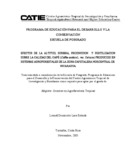| dc.description.abstract | Con el objetivo de valorar los efectos de los factores altitud, sombra, rendimiento y fertilización sobre la calidad del café se colectaron un total de 67 muestras de café de fincas comerciales en la región cafetalera norcentral de Nicaragua. La altitud presentó la mayor influencia sobre la determinación de la calidad física del grano (tamaño, peso y granos imperfectos), organoléptica (aroma, cuerpo, acidez, sabor y preferencia) y compuestos bioquímicos (cafeína, trigonelina, materia grasa y acidos clorogénicos). La sombra influyó significativamente sobre la calidad física del grano (mayor tamaño y peso, y menor porcentaje de granos imperfectos) y su composición bioquímica (cafeina, sacarosa y acidos clorogénicos); además, mostró una correlación positiva y significativa sobre el amargo de bebida. La sombra y fertilización pueden compensar parcialmente las desventajas de los lotes ubicados en las zonas de baja altitud. Los compuestos bioquímicos mostraron una fuerte relación con las características organolépticas, estos compuestos podrían utilizarse como indicadores de la calidad del café y así eliminar el error humano debido a las discrepancias que existen entre catadores con diferentes experiencias.
With the objective of evaluating the effects of altitude, shade, yield and fertilization on coffee quality, a total of 67 coffee samples of coffee plantations was collected in the Northern Central region of Nicaragua. Altitude influenced the greatest the determination of coffee physical quality (larger, heavier beans and lower percentage of imperfects beans), organoleptic quality (aroma, body, acidity, flavor and preference) and biochemical compounds (caffeine, trigonelline, sucrose, chlorogenic acids and fat). Shade influenced significantly the physical quality (larger, heavier beans and lower percentage of imperfects beans) and biochemical composition (caffeine, chlorogenic acids and sucrose) of coffee beans; in addition, a high correlation was observed between shade and the bitterness of beverage. Shade and fertilization can partially compensate the disadvantages of plantations locatec at low altitude. Biochemical compounds showed a strong relationship with the organoleptic characteristics, these compounds could be used as indicators of coffee quality and thus to eliminate the human error due to the discrepancies that exist between tasters with different experiences. | es_ES |


